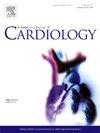Changes in syndecan-1 concentration in the coronary sinus immediately after cardiac reperfusion reflect postoperative myocardial injury
IF 3.2
2区 医学
Q2 CARDIAC & CARDIOVASCULAR SYSTEMS
引用次数: 0
Abstract
Objectives
Endothelial glycocalyx (eGCX) is shed into the bloodstream during reperfusion injury and ischemia, and its core proteins, syndecan-1 and glypican-1, can be measured in the blood. However, no studies have measured cardiac serum syndecan-1 concentrations in blood from the coronary sinus. Therefore, we aimed to examine the relationship between the degree and changes in eGCX damage and postoperative clinical outcomes using blood drawn from the coronary sinus.
Methods
Serum eGCX concentrations in the coronary sinus of 56 patients who underwent cardiac and thoracic aortic surgery with combined ante- and retrograde cardioplegia were analyzed. The association between maximum postoperative troponin T (TnT) level, as a myocardial damage marker, and eGCX injury markers, including syndecan-1 and glypican-1, measured in coronary sinus blood drawn immediately after reperfusion, was assessed. The association between eGCX injury markers and duration of cardioplegic arrest was also investigated.
Results
An association between degree of change in coronary sinus serum syndecan-1 concentration during reperfusion and postoperative maximum serum TnT levels was observed. No such association was found between the degree of change in coronary sinus serum glypican-1 concentration during reperfusion and postoperative serum TnT levels. Similar results were obtained for somatic circulation. Moreover, an association between maximum change in serum syndecan-1 concentration in the coronary sinus during reperfusion and cardioplegic arrest duration was observed. No such association was found for glypican-1 concentration.
Conclusions
The degree of endothelial damage to the coronary sinuses during reperfusion may predict myocardial injury following cardiac surgery.
心脏再灌注后冠状窦内syndecan-1浓度的变化反映了术后心肌损伤
目的内皮糖萼(eGCX)在再灌注损伤和缺血时进入血流,检测其核心蛋白syndecan-1和glypican-1。然而,没有研究测量心脏血清syndecan-1在冠状窦血液中的浓度。因此,我们的目的是通过冠状窦采血来研究eGCX损伤的程度和变化与术后临床结果之间的关系。方法对56例行心脏胸主动脉手术合并逆行性心脏骤停的患者进行冠状动脉窦eGCX血药浓度分析。评估术后最大肌钙蛋白T (TnT)水平(作为心肌损伤标志物)与eGCX损伤标志物(包括syndecan-1和glypican-1)在再灌注后立即取冠状窦血中测量的相关性。eGCX损伤标志物与心脏骤停持续时间之间的关系也被调查。结果观察冠状窦再灌注时血清syndecan-1浓度变化程度与术后血清最高TnT水平之间的相关性。冠状窦再灌注时血清甘肽-1浓度的变化程度与术后血清TnT水平之间未发现这种相关性。在人体循环中也得到了类似的结果。此外,还观察到冠状窦再灌注时血清syndecan-1浓度的最大变化与心脏骤停持续时间之间的关联。glypican-1浓度没有发现这种关联。结论再灌注时冠状窦内皮损伤程度可预测心脏手术后心肌损伤。
本文章由计算机程序翻译,如有差异,请以英文原文为准。
求助全文
约1分钟内获得全文
求助全文
来源期刊

International journal of cardiology
医学-心血管系统
CiteScore
6.80
自引率
5.70%
发文量
758
审稿时长
44 days
期刊介绍:
The International Journal of Cardiology is devoted to cardiology in the broadest sense. Both basic research and clinical papers can be submitted. The journal serves the interest of both practicing clinicians and researchers.
In addition to original papers, we are launching a range of new manuscript types, including Consensus and Position Papers, Systematic Reviews, Meta-analyses, and Short communications. Case reports are no longer acceptable. Controversial techniques, issues on health policy and social medicine are discussed and serve as useful tools for encouraging debate.
 求助内容:
求助内容: 应助结果提醒方式:
应助结果提醒方式:


